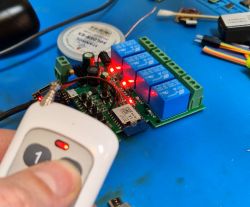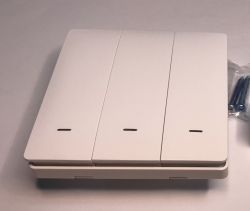FAQ
TL;DR: Use DMX RGB fixtures (+40–50 PLN each) to simplify wiring; "I definitely prefer RGB with built‑in DMX controller." That setup can also coordinate valves and a pump inverter. [Elektroda, rogerrrr, post #17043078]
Why it matters: This FAQ helps builders of a 9‑jet fountain choose reliable, budget‑aware control for solenoid valves and RGB lighting.
Quick Facts
- Budget declared at ~4000 zł; this limits controller features and expansion headroom. [Elektroda, blazej2, post #17042444]
- RGB fixtures with built‑in DMX cost +40–50 PLN each, reduce cabling, and allow unified control. [Elektroda, rogerrrr, post #17043078]
- A PLC was recommended as the control core for this project. [Elektroda, bhtom, post #17043854]
- For 230 Vac coils: use nine SSRs as the power stage; pair with a PLC with transistor outputs; PLC cost approx. 600–800 net (FATEK 24MA, 10 outputs). [Elektroda, pafciowaw, post #17046903]
- One stated nozzle: 3/4" thread, 1.5 m lift, 61 l/min at 0.6 bar. [Elektroda, blazej2, post #17045377]
What’s a practical control architecture for nine solenoid valves?
Use a small PLC with transistor outputs driving a bank of nine SSRs. The SSRs handle 230 Vac coils without contact wear. Program sequences in the PLC and trigger scenes via inputs or a real‑time clock. This scales cleanly to nine jets. [Elektroda, pafciowaw, post #17046903]
Should I choose RGB fixtures with built‑in DMX controllers?
Yes. They cost about 40–50 PLN more per fixture, but you run less wiring and gain rich effects control. The same DMX ecosystem can also coordinate valves and even a pump inverter. This simplifies integration for shows. [Elektroda, rogerrrr, post #17043078]
Can I use 230 Vac solenoid coils in a technical well?
Yes. The valves will sit in a technical well, so a 230 V supply is acceptable in this design. With that decision, you can plan the control stage and wiring layout around mains‑rated actuation. [Elektroda, blazej2, post #17046340]
What’s the best way to switch 230 Vac solenoid valves?
Use solid‑state relays (SSRs). They offer zero‑cross switching and long life. Pair them with a PLC’s transistor outputs. As one expert noted, "no sparking of contacts," which reduces wear and maintenance over time. Size SSRs for coil current. [Elektroda, pafciowaw, post #17046903]
Which PLC fits nine valves, and what does it cost?
A PLC with at least 9–10 outputs fits. One cited option is a FATEK 24MA with 10 outputs. The stated cost range is approx. 600–800 PLN net. That covers scheduling via a real‑time clock and scene selection via inputs. [Elektroda, pafciowaw, post #17046903]
How can I program different sequences or scenes for the fountain?
Use the PLC’s real‑time clock for timed sequences. Create additional scenes and select them through dedicated inputs. This lets you run different patterns at different times or on demand. It’s flexible without adding extra hardware. [Elektroda, pafciowaw, post #17046903]
Is 16 mm PE pipe adequate for these nozzles?
No. 16 mm PE is suitable for lawn sprinklers, not high‑flow fountain nozzles. Using it will constrain flow and performance. Plan larger distribution lines to avoid starving the jets. Treat 16 mm only as a tiny branch if ever used. [Elektroda, pafciowaw, post #17044430]
What pipe sizes are commonly run to fountain nozzles?
Installers report much larger feeds to nozzles. As one practitioner put it, "I run 40–50mm pipe to the nozzles in the fountains." Upsizing reduces pressure drop and preserves jet shape. Size per your nozzle spec and run length. [Elektroda, technikabasenowa, post #17044399]
What flow and pressure were stated for the chosen nozzle?
The shared spec was a foaming nozzle with a 3/4" thread. It lists about 1.5 m lift at 0.6 bar and 61 l/min. Use this to estimate total flow and pump demand across nine jets. Validate with vendor curves. [Elektroda, blazej2, post #17045377]
How large might the pump need to be for nine such nozzles?
One expert estimated that with nine nozzles, you’re around 40 m³ total, needing a strong pump. They suggested a good pump might cost about 5–6 thousand PLN. Budget this early to avoid shortfalls. [Elektroda, technikabasenowa, post #17045408]
How do I wire a PLC, SSRs, and 230 Vac valves? (3 steps)
- Choose a PLC with enough transistor outputs and a real‑time clock.
- Wire each PLC output to an SSR input; wire each SSR output to a valve coil (230 Vac).
- Program time‑based scenes and input‑triggered modes; test each SSR channel under load. [Elektroda, pafciowaw, post #17046903]
Can DMX also control valves and a pump inverter along with RGB?
Yes. Selecting RGB fixtures with integrated DMX simplifies lighting. The same approach can integrate valve control and possibly a pump inverter. This unifies show control under one protocol for synchronized effects. [Elektroda, rogerrrr, post #17043078]
What should I document before buying parts?
List what you already have and what you must buy. If valves are chosen, record the model and coil parameters. This ensures the controller, SSRs, and power supplies match real loads and wiring constraints. [Elektroda, rogerrrr, post #17043078]
Are timing relays enough, or should I use a PLC?
A PLC gives more flexibility for scenes, scheduling, and expansion. It was explicitly recommended over simpler approaches here. As one expert advised, "I would think about a PLC." That suits multi‑jet fountains well. [Elektroda, bhtom, post #17043854]






